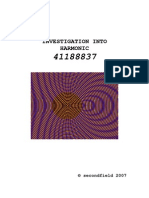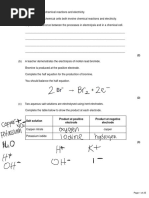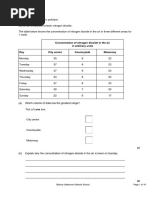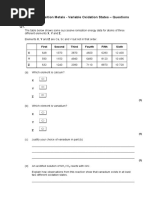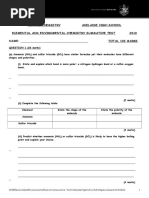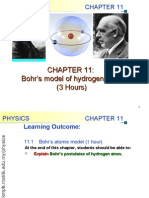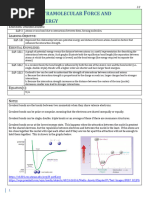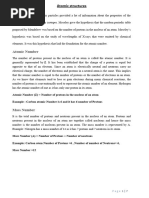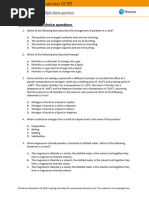Year 9 Exam
Year 9 Exam
Uploaded by
Si Hang Ethan LiCopyright:
Available Formats
Year 9 Exam
Year 9 Exam
Uploaded by
Si Hang Ethan LiOriginal Title
Copyright
Available Formats
Share this document
Did you find this document useful?
Is this content inappropriate?
Copyright:
Available Formats
Year 9 Exam
Year 9 Exam
Uploaded by
Si Hang Ethan LiCopyright:
Available Formats
The diagram below represents different models of the atom.
1.
(a) Which diagram shows the plum pudding model of the atom?
Tick one box.
(1)
(b) Which diagram shows the model of the atom developed from the alpha particle scattering
experiment?
Tick one box.
(1)
(c) Which diagram shows the model of the atom resulting from Bohr’s work?
Tick one box.
(1)
(d) Define the mass number of an atom.
___________________________________________________________________
___________________________________________________________________
(1)
Watford Grammar School for Boys Page 1 of 20
(e) Element X has two isotopes. Their mass numbers are 69 and 71
The percentage abundance of each isotope is:
• 60% of 69X
• 40% of 71X
Estimate the relative atomic mass of element X.
Tick one box.
< 69.5
Between 69.5 and 70.0
Between 70.0 and 70.5
> 70.5
(1)
(f) Chadwick’s experimental work on the atom led to a better understanding of isotopes.
Explain how his work led to this understanding.
___________________________________________________________________
___________________________________________________________________
___________________________________________________________________
___________________________________________________________________
___________________________________________________________________
___________________________________________________________________
(3)
(Total 8 marks)
Watford Grammar School for Boys Page 2 of 20
Iron is extracted from iron oxide in the blast furnace.
2.
(a) The equation for one of the reactions in the blast furnace is:
Fe2O3 + 3CO 2Fe + 3CO2
(i) Complete the word equation for this reaction.
iron oxide carbon
+ ________________ + ________________
monoxide
(2)
(ii) Oxygen is removed from iron oxide in the blast furnace.
Draw a ring around the correct answer to complete the sentence.
neutralised.
The iron oxide is oxidised.
reduced.
(1)
Watford Grammar School for Boys Page 3 of 20
(b) The diagrams represent pure iron and iron from the blast furnace.
Pure iron Iron from the blast furnace
(i) Draw one line from each statement to the correct explanation.
(2)
(ii) Explain why iron from the blast furnace is harder than pure iron.
Use the diagrams on page 4 to help you.
______________________________________________________________
______________________________________________________________
______________________________________________________________
______________________________________________________________
(2)
(Total 7 marks)
Watford Grammar School for Boys Page 4 of 20
A student investigated the rate of reaction between sodium thiosulfate and dilute hydrochloric
3. acid.
The student placed a conical flask over a cross on a piece of paper.
The student mixed the solutions in the flask.
The solution slowly went cloudy.
The student timed how long it took until the cross could not be seen.
The equation for the reaction is:
Na2S2O3(aq) + 2 HCl(aq) → 2 NaCl(aq) + H2O(l) + SO2(g) + S(s)
sodium hydrochloric sodium sulfur
+ → + water + + sulfur
thiosulfate acid chloride dioxide
(a) Explain why the solution goes cloudy.
___________________________________________________________________
___________________________________________________________________
___________________________________________________________________
___________________________________________________________________
(2)
Watford Grammar School for Boys Page 5 of 20
(b) The student repeated the experiment with different concentrations of sodium thiosulfate.
Time taken until the cross could not be seen
Concentration of
in seconds
sodium thiosulfate
in moles per dm3
Trial 1 Trial 2 Trial 3 Mean
0.040 71 67 69 69
0.060 42 45 45 44
0.080 31 41 33
(i) Calculate the mean time for 0.080 moles per dm3 of sodium thiosulfate.
______________________________________________________________
______________________________________________________________
______________________________________________________________
Mean = ____________________ seconds
(2)
(ii) Describe and explain, in terms of particles and collisions, the effect that increasing
the concentration of sodium thiosulfate has on the rate of the reaction.
______________________________________________________________
______________________________________________________________
______________________________________________________________
______________________________________________________________
______________________________________________________________
______________________________________________________________
(3)
(Total 7 marks)
Watford Grammar School for Boys Page 6 of 20
This question is about the development of scientific theories.
4.
The diagram below shows a timeline of some important steps in the development of the model of
the atom.
(a) The plum pudding model did not have a nucleus.
Describe three other differences between the nuclear model of the atom and the plum
pudding model.
1 _________________________________________________________________
___________________________________________________________________
___________________________________________________________________
2 _________________________________________________________________
___________________________________________________________________
___________________________________________________________________
3 _________________________________________________________________
___________________________________________________________________
___________________________________________________________________
(3)
Watford Grammar School for Boys Page 7 of 20
(b) Niels Bohr adapted the nuclear model.
Describe the change that Bohr made to the nuclear model.
___________________________________________________________________
___________________________________________________________________
___________________________________________________________________
___________________________________________________________________
(2)
(c) Mendeleev published his periodic table in 1869.
Mendeleev arranged the elements in order of atomic weight.
Mendeleev then reversed the order of some pairs of elements.
A student suggested Mendeleev’s reason for reversing the order was to arrange the
elements in order of atomic number.
Explain why the student’s suggestion cannot be correct.
Use the diagram above.
___________________________________________________________________
___________________________________________________________________
___________________________________________________________________
___________________________________________________________________
(2)
(d) Give the correct reason why Mendeleev reversed the order of some pairs of elements.
___________________________________________________________________
___________________________________________________________________
(1)
(Total 8 marks)
The hydrogen halides (hydrogen fluoride, hydrogen chloride, hydrogen bromide and hydrogen
5. iodide) are important chemicals.
The diagram below represents a molecule of hydrogen chloride.
Watford Grammar School for Boys Page 8 of 20
(i) What type of particles are represented by the crosses (X)?
___________________________________________________________________
(1)
(ii) What type of chemical bond holds the atoms in this molecule together?
___________________________________________________________________
(1)
(iii) Would you expect hydrogen chloride to be a gas, a liquid or a solid, at room temperature
and pressure? Explain your answer.
___________________________________________________________________
___________________________________________________________________
___________________________________________________________________
(3)
(Total 5 marks)
Graphite and diamond are different forms of the element carbon.
6. Graphite and diamond have different properties.
The structures of graphite and diamond are shown below.
Graphite Diamond
Watford Grammar School for Boys Page 9 of 20
(a) Graphite is softer than diamond.
Explain why.
___________________________________________________________________
___________________________________________________________________
___________________________________________________________________
___________________________________________________________________
___________________________________________________________________
___________________________________________________________________
___________________________________________________________________
___________________________________________________________________
(4)
(b) Graphite conducts electricity, but diamond does not.
Explain why.
___________________________________________________________________
___________________________________________________________________
___________________________________________________________________
___________________________________________________________________
___________________________________________________________________
___________________________________________________________________
(3)
(Total 7 marks)
Solutions A and B are colourless. When they are mixed, they react and turn blue after a period of
7. time. A student investigated how temperature affected the rate of reaction between solutions A
and B. The rate was measured by timing how long the mixture took to turn blue.
The results are shown in the table.
Temperature in °C 22 25 34 45 51
Time taken to turn blue, in seconds 290 250 200 170 160
Watford Grammar School for Boys Page 10 of 20
(a) (i) Draw a graph for these results.
(3)
(ii) Use your graph to find how long it takes the solution to turn blue at 40°C.
Time = _____________________ s
(1)
(b) (i) How does the rate of reaction change as the temperature is increased?
_________________________________________________________
_________________________________________________________
(1)
Watford Grammar School for Boys Page 11 of 20
(ii) Explain, in terms of particles, why temperature has this effect on the rate of reaction.
To gain full marks in this question you should write your ideas in good English.
Put them into a sensible order and use the correct scientific words.
_________________________________________________________
_________________________________________________________
_________________________________________________________
_________________________________________________________
_________________________________________________________
_________________________________________________________
(3)
(c) State one variable that must be kept constant to make this experiment a fair test.
______________________________________________________________
(1)
(Total 9 marks)
Soluble salts are formed by reacting metal oxides with acids.
8.
(a) Give one other type of substance that can react with an acid to form a soluble salt.
___________________________________________________________________
(1)
(b) Calcium nitrate contains the ions Ca2+ and NO3−
Give the formula of calcium nitrate.
___________________________________________________________________
(1)
Watford Grammar School for Boys Page 12 of 20
(c) Describe a method to make pure, dry crystals of magnesium sulfate from a metal oxide and
a dilute acid.
___________________________________________________________________
___________________________________________________________________
___________________________________________________________________
___________________________________________________________________
___________________________________________________________________
___________________________________________________________________
___________________________________________________________________
___________________________________________________________________
___________________________________________________________________
___________________________________________________________________
___________________________________________________________________
___________________________________________________________________
___________________________________________________________________
___________________________________________________________________
___________________________________________________________________
___________________________________________________________________
___________________________________________________________________
___________________________________________________________________
___________________________________________________________________
___________________________________________________________________
(6)
(Total 8 marks)
Watford Grammar School for Boys Page 13 of 20
Mark schemes
(a) B
1. 1
(b) C
1
(c) A
1
(d) sum of protons and neutrons
allow number of protons and neutrons
1
(e) between 69.5 and 70.0
1
(f) Chadwick provided the evidence to show the existence of neutrons
allow Chadwick discovered neutrons
1
(this was necessary because) isotopes have the same number of protons
allow (this was necessary because) isotopes have the
same atomic number
or
(this was necessary because) isotopes are atoms of the same element
ignore isotopes have the same number of electrons
1
but with different numbers of neutrons
allow but with different mass (numbers)
1
[8]
(a) (i) iron
2.
either order
1
carbon dioxide
1
(ii) reduced
1
Watford Grammar School for Boys Page 14 of 20
(b) (i) Statemant Explanation
each correct line gains 1 mark
extra lines from statement negate the mark
max. 2
(ii) the layers / rows are distorted / disrupted or it doesn’t occur in layers or the
atoms are different
1
so cannot slide over one another or slide less easily
1
[7]
(a) because sulfur / S forms
3. 1
which is insoluble / a solid / a precipitate
1
(b) (i) 32
correct answer with or without working gains 2 marks
accept evidence of 31 + 33 / 2 for 1 mark
allow 35 for 1 mark
2
(ii) reaction rate increases
if incorrect reference to energy = max 2
1
because of more particles (per unit volume)
allow because particles are closer together
1
Watford Grammar School for Boys Page 15 of 20
and because there is an increase in frequency of collisions
accept because particles are more likely to collide or higher chance
of collision
ignore more (successful) collisions
1
[7]
(a) any three from: (nuclear model)
4. • mostly empty space
allow the plum pudding model has no empty space
allow the plum pudding model is solid
• the positive charge is (all) in the nucleus
allow in the plum pudding model the atom is a ball of
positive charge (with embedded electrons)
do not accept reference to protons
• the mass is concentrated in the nucleus
allow in the plum pudding model the mass is spread out
do not accept reference to neutrons
• the electrons and the nucleus are separate
allow in the plum pudding model the electrons are
embedded
allow in the nuclear model the electrons are in orbits
3
(b) electrons orbit the nucleus
do not accept reference to protons / neutrons
allow electrons are in energy levels around the nucleus
or
allow electrons are in shells around the nucleus
1
electrons are at specific distances from the nucleus
1
(c) atomic number is the number of protons
1
(and) protons were not discovered until later
ignore electrons / neutrons were not discovered until
later
1
(d) so their properties matched the rest of the group
allow converse
1
[8]
Watford Grammar School for Boys Page 16 of 20
(i) electrons 1
5.
for 1 mark
(ii) covalent 1
for 1 mark
(iii) made of small molecules:
usually gas or liquid ) dependent on
have low melting points ) having first
have low boiling points ) point above
forces between molecules are weak
any 1 for 1 mark
3
[5]
(a) Graphite:
6.
because the layers (of carbon atoms) in graphite can move / slide
it = graphite
1
this is because there are only weak intermolecular forces or weak forces between layers
accept Van der Waals’ forces allow no covalent bonds between
layers
1
Diamond:
however, in diamond, each carbon atom is (strongly / covalently) bonded to 4 others
allow diamond has three dimensional / tetrahedral structure
1
so no carbon / atoms able to move / slide
allow so no layers to slide or so diamond is rigid
1
(b) because graphite has delocalised electrons / sea of electrons
allow free / mobile / roaming electrons
1
which can carry charge / current or move through the structure
1
however, diamond has no delocalised electrons
accept however, diamond has all (outer) electrons used in bonding
1
[7]
Watford Grammar School for Boys Page 17 of 20
7.
(a) (i) accurate plotting of points ( square)
2 marks for all points
1 mark for 3 or 4 points
2
sensible smooth curve
reasonable attempt
do not accept double lines or dot to
dot
1
(ii) accurately read from their graph to
square 1
(b) (i) (as temperature increases) rate increases
accept speeds up, gets faster, gets quicker
accept higher speed
do not accept gets bigger / higher unqualified
do not accept answers about time on its own
1
(ii) Quality of Written Communication
The answer to this question requires ideas in good English in a
sensible order with correct use of scientific terms. Quality of written communication
should be considered in crediting points in the
mark scheme.
maximum 2 marks if ideas not expressed well
any three from:
for converse maximum 2 marks
particles have more energy
higher kinetic energy
particles move faster
do not accept move more or vibrate more
3
more collisions
accept greater rate of collisions
more energetic / successful / harder collisions
more particles have activation energy
Watford Grammar School for Boys Page 18 of 20
(c) concentration (of solutions) or volume (of solutions)
accept ‘how much of’
accept references to intensity of colour
accept same endpoint
accept rate of stirring / shaking
do not accept reference to solids or catalysts etc
ignore containers
do not accept pH
1
[9]
(a) any one from:
8. • metal
• (metal) hydroxide
allow ammonium hydroxide
• (metal) carbonate
allow ammonium carbonate
• alkali
allow soluble base
allow ammonia
1
allow named example
allow correct formula
ignore base
(b) Ca(NO3)2
allow Ca2+(NO3−)2
1
(c) Level 3: The method would lead to the production of a valid outcome. All key steps
are identified and logically sequenced.
5−6
Level 2: The method would not necessarily lead to a valid outcome. Most steps are
identified, but the method is not fully logically sequenced.
3−4
Level 1: The method would not lead to a valid outcome. Some relevant steps are
identified, but links are not made clear.
1−2
No relevant content
0
Watford Grammar School for Boys Page 19 of 20
Indicative content
• use magnesium oxide and sulfuric acid
• add sulfuric acid to a beaker
• warm sulfuric acid
• add magnesium oxide
• stir
• continue adding until magnesium oxide is in excess
• filter
• using a filter paper and funnel
• to remove excess magnesium oxide
• heat solution in an evaporating basin
• to crystallisation point
• leave to crystallise
• pat dry with filter paper
credit may be given for diagrams
[8]
Watford Grammar School for Boys Page 20 of 20
You might also like
- California Science Grade 5 - Answer KeyDocument13 pagesCalifornia Science Grade 5 - Answer KeyMarina DonofrioNo ratings yet
- World Grid, Bruce Cathie, Chemtrails, UFO's, Secret Bases New ZealandDocument44 pagesWorld Grid, Bruce Cathie, Chemtrails, UFO's, Secret Bases New Zealandsecondfield100% (16)
- Atoms, Radiation, and Radiation Protection: James E. TurnerDocument9 pagesAtoms, Radiation, and Radiation Protection: James E. TurnerSubhash KorumilliNo ratings yet
- NSHE GRADE 7 NotesDocument78 pagesNSHE GRADE 7 NotesJB Mangundu83% (12)
- Redox Titration Questions 2Document11 pagesRedox Titration Questions 2Jaimi RosarioNo ratings yet
- 11bsc1_10copyDocument24 pages11bsc1_10copyAruj Tahir ShahNo ratings yet
- C2 Bonding Structure and Properties HTDocument64 pagesC2 Bonding Structure and Properties HTMadhavi OchaniNo ratings yet
- ShapesofcomplexionsDocument41 pagesShapesofcomplexions/ “Nu” /No ratings yet
- VariableoxidationstatesDocument84 pagesVariableoxidationstates/ “Nu” /No ratings yet
- Ionic BondingDocument15 pagesIonic BondingDua AamirNo ratings yet
- C6 Hard QPDocument25 pagesC6 Hard QPlizablatchfordNo ratings yet
- Chem Paper 1 Pracs QPDocument21 pagesChem Paper 1 Pracs QPlizablatchfordNo ratings yet
- Year 11 Chemistry Time: 2 HoursDocument12 pagesYear 11 Chemistry Time: 2 HoursAdrianHedleyNo ratings yet
- GCSE - A Level Chemistry Transition Gcse Questions.199272016Document13 pagesGCSE - A Level Chemistry Transition Gcse Questions.199272016miyu kanzakiNo ratings yet
- Bonding and StructureDocument30 pagesBonding and Structurei.naiduNo ratings yet
- Bonding Exam Style Questions (Chemistry)Document30 pagesBonding Exam Style Questions (Chemistry)Temilola OwolabiNo ratings yet
- 2021 SAJC Prelim P2 QnsDocument24 pages2021 SAJC Prelim P2 Qns6fhntwb78dNo ratings yet
- QuantitativeDocument29 pagesQuantitativeapi-422428700No ratings yet
- Sample Questions and Markscheme For Year 10 Chemistry ExamDocument9 pagesSample Questions and Markscheme For Year 10 Chemistry ExamstilelessNo ratings yet
- GeneralpropertiesDocument31 pagesGeneralproperties/ “Nu” /No ratings yet
- Atomic Structure AlevelDocument31 pagesAtomic Structure Alevelmohammedsafia965No ratings yet
- c1 Atomic Structure and Periodic Table HT HW QuestionsDocument19 pagesc1 Atomic Structure and Periodic Table HT HW Questionsmariamthomas5510No ratings yet
- 2.4 Transition Metals Formation of Coloured Ions QsDocument27 pages2.4 Transition Metals Formation of Coloured Ions QsJesulayomi BolajiNo ratings yet
- New Document 1Document7 pagesNew Document 1James YangNo ratings yet
- Chemical Changes Study GuideDocument30 pagesChemical Changes Study GuidedaniyahmiahNo ratings yet
- Using Earths Resources Exam Practice GCSEDocument14 pagesUsing Earths Resources Exam Practice GCSEPaul GillNo ratings yet
- C4 Chemical Changes HTDocument72 pagesC4 Chemical Changes HTMadhavi OchaniNo ratings yet
- Exampro - Acids and AlkalisDocument72 pagesExampro - Acids and AlkalisMadhavi OchaniNo ratings yet
- c1 Atomic Strcuture and Periodic TableDocument108 pagesc1 Atomic Strcuture and Periodic TableDaniel DuNo ratings yet
- 3. Quantititive Chemistry Paper 1 (1)Document37 pages3. Quantititive Chemistry Paper 1 (1)Jack Dicconson (Jack)No ratings yet
- Atomic Structure Part 2Document53 pagesAtomic Structure Part 2ashgan.adelNo ratings yet
- Bonding Structure - Properties - Paper 1Document30 pagesBonding Structure - Properties - Paper 1annie24586No ratings yet
- Gases and Solutions QPDocument13 pagesGases and Solutions QPGbenga AjibikeNo ratings yet
- ALKALI METALSDocument13 pagesALKALI METALSnivss1215No ratings yet
- Quantititive Chemistry - Paper 1 TES - 4Document37 pagesQuantititive Chemistry - Paper 1 TES - 4KshitijNo ratings yet
- Energy ChangesDocument27 pagesEnergy Changesapi-422428700No ratings yet
- Redox Pack 2Document12 pagesRedox Pack 2Umar SiddiqueNo ratings yet
- 2.2 Transition Metals Substitution Reactions QsDocument23 pages2.2 Transition Metals Substitution Reactions QsJesulayomi BolajiNo ratings yet
- L3 Mock 2 Chemistry RevisionDocument22 pagesL3 Mock 2 Chemistry Revisioninstagramiman12345No ratings yet
- 3.5 Use of Amount of Substance On Volumes of Gases QP (Separate Only)Document17 pages3.5 Use of Amount of Substance On Volumes of Gases QP (Separate Only)Charu KochharNo ratings yet
- Electrolysis 5.4-5.6 ReviewDocument5 pagesElectrolysis 5.4-5.6 ReviewNerisa Nurul BulanNo ratings yet
- 2023 Paper 1 QuestionsDocument23 pages2023 Paper 1 QuestionsGabriel HoNo ratings yet
- Chemistry KS4 LZ 2.1Document21 pagesChemistry KS4 LZ 2.1Wreck RalphNo ratings yet
- Acids BasesandsaltsDocument26 pagesAcids Basesandsaltsremaselshazly76No ratings yet
- 3.5 Use of Amount of Substance On Volumes of Gases QPDocument17 pages3.5 Use of Amount of Substance On Volumes of Gases QPTang Hing Yiu, SamuelNo ratings yet
- Test 2-P2Document8 pagesTest 2-P2Salman Ul MoazzamNo ratings yet
- Atomic Structure QuestionsDocument11 pagesAtomic Structure Questionsemihk626No ratings yet
- Chemical Calculations Questions - Many and HardDocument26 pagesChemical Calculations Questions - Many and Hard19gururNo ratings yet
- Periodic Table 5 QPDocument11 pagesPeriodic Table 5 QPYabhijit DuttaNo ratings yet
- Paper 1 AQA 2023 ASDocument27 pagesPaper 1 AQA 2023 AS2024a.saeedNo ratings yet
- Metallic Bonding RevisionDocument11 pagesMetallic Bonding RevisionStaceNo ratings yet
- 11L2 Chemistry Paper 2HDocument10 pages11L2 Chemistry Paper 2HJivon MathewNo ratings yet
- Autumn Pathway ABDocument42 pagesAutumn Pathway ABH ChowdreyNo ratings yet
- 2.5 Transition Metals Variable Oxidation States QsDocument37 pages2.5 Transition Metals Variable Oxidation States QsJesulayomi BolajiNo ratings yet
- 2010 Elemental and Environmental Summative Test 1 and 2Document24 pages2010 Elemental and Environmental Summative Test 1 and 2Jessica NguyenNo ratings yet
- Ionic bonding booklet - unedited AQADocument24 pagesIonic bonding booklet - unedited AQAsamuel.abeikuNo ratings yet
- Week 2 Chemistry Paper 1Document13 pagesWeek 2 Chemistry Paper 19wgd495gqyNo ratings yet
- Chem Test 1 2019 Section BDocument8 pagesChem Test 1 2019 Section BAmirah Noor AffandiNo ratings yet
- BondingDocument24 pagesBondingapi-422428700No ratings yet
- ClassificationDocument21 pagesClassificationaadityagamingemailNo ratings yet
- 15.1 chemistryDocument25 pages15.1 chemistryjacksonNo ratings yet
- Mock 1 Paper 2 Code 200112Document14 pagesMock 1 Paper 2 Code 200112Quazi Sahil HossainNo ratings yet
- 3.1.8.1 Born-Haber Cycles (A-Level Only)Document73 pages3.1.8.1 Born-Haber Cycles (A-Level Only)jaisisantosh2007No ratings yet
- Physics 12th Grade SA2 2Document9 pagesPhysics 12th Grade SA2 2ashika2731No ratings yet
- Unit IDocument79 pagesUnit IMaadhavaNo ratings yet
- Chemistry NoteDocument20 pagesChemistry NoteCarlNo ratings yet
- Properties of Electric Charges, Electric ForceDocument44 pagesProperties of Electric Charges, Electric ForceDyan NavarroNo ratings yet
- Atomic and Molecular Spectroscopy Lecture 2Document29 pagesAtomic and Molecular Spectroscopy Lecture 2Hammed LawalNo ratings yet
- FPSC Test Session 02 of 28Document35 pagesFPSC Test Session 02 of 28ali hassanNo ratings yet
- ELEX Reviewer 1Document8 pagesELEX Reviewer 1chapatzNo ratings yet
- Matriculation Physics (Bohr's Model of Hydrogen Atom)Document39 pagesMatriculation Physics (Bohr's Model of Hydrogen Atom)ridwan100% (1)
- Question Bank ChemistryDocument2 pagesQuestion Bank Chemistrytigervkm1900No ratings yet
- 2.2 Intramolecular Force and Potential Energy Student 2Document3 pages2.2 Intramolecular Force and Potential Energy Student 2holaholaholacarlottaNo ratings yet
- CHAPTER 8 - Lecture NotesDocument68 pagesCHAPTER 8 - Lecture NotesAlex100% (1)
- Kognity DP Chemistry: Syllabus alignmentsDocument36 pagesKognity DP Chemistry: Syllabus alignmentscastejon.emmaNo ratings yet
- Thermal Properties of Matter Sample ProblemsDocument4 pagesThermal Properties of Matter Sample ProblemsEdogawaNo ratings yet
- More Chapter 7 1-Multielectron AtomsDocument4 pagesMore Chapter 7 1-Multielectron AtomsMasanja SayiNo ratings yet
- Chapter 7Document16 pagesChapter 7alyalaswad4445No ratings yet
- Assignment 1 MaterialDocument8 pagesAssignment 1 MaterialHassan YounasNo ratings yet
- Fundamentals of Radiologic Physics Course OutlineDocument7 pagesFundamentals of Radiologic Physics Course OutlineJustin Zeus Operio100% (1)
- 8th Grade GlossaryDocument17 pages8th Grade GlossaryCamille LiqueNo ratings yet
- Ncert Solutions Class 9 Science Chapter 4 Structure of the Atom 0Document29 pagesNcert Solutions Class 9 Science Chapter 4 Structure of the Atom 0yourcooperativeneighbourNo ratings yet
- Most and Least LearnedDocument20 pagesMost and Least LearnedMariss Joy100% (1)
- Isotopes and IsobarsDocument7 pagesIsotopes and IsobarsUttam Kumar GhoshNo ratings yet
- 02 Atomic Structure Que. Final EDocument31 pages02 Atomic Structure Que. Final EDIPESHNo ratings yet
- Learning Competencies in ScienceDocument29 pagesLearning Competencies in ScienceMarievic DavidNo ratings yet
- Jottings From The Treatises of The Late Leader Sumugam Aiyar of The Brahmaswarupini MovementDocument17 pagesJottings From The Treatises of The Late Leader Sumugam Aiyar of The Brahmaswarupini MovementK CircleNo ratings yet
- Lecture 1 - Introduction and Semiconductors PDFDocument25 pagesLecture 1 - Introduction and Semiconductors PDFHamza ShahidNo ratings yet
- Igcse Doubleaward Chem MCQ Unit1Document8 pagesIgcse Doubleaward Chem MCQ Unit1Jorge Andrés Solano Torres100% (1)

